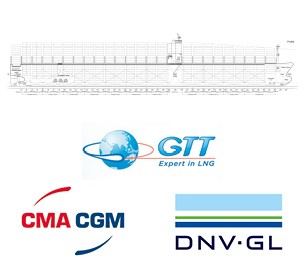Ship owner and operator CMA CGM, cryogenic membrane containment systems provider GTT (Gaztransport & Technigaz) and classification society DNV GL have partnered to conduct a technical and feasibility study for a concept vessel dubbed the “Piston Engine Room Free Efficient Containership (PERFECt)”.
What Are The Concept Vessel Specifics?
This concept mega box vessel is LNG-fuelled, electrically driven and powered by a combined gas and steam turbine.
Two 10,960 m³ LNG fuel tanks are located below the deck house. This tank capacity would give the vessel enough fuel for an Asia/Europe round trip. The gas and steam turbines are integrated at deck level within the same deck house as the tanks, therefore the space normally occupied by the conventional engine room can be used to increase cargo capacity significantly.
The dissociation of electric power generation from electric propulsion allows the electric power plant to be moved away from the main propulsion system, giving further flexibility. In fact, in this concept vessel an engine room is no longer required.
Three electric main motors, arranged on one common shaft, can be run fully independently of each other providing increased redundancy and reliability and a high level of safety.
How Was The Study Conducted?
In a comprehensive analysis with the DNV GL COSSMOS tool, components of the potential power production and propulsion system were simulated in order to analyse the COGAS system. With DNV GL COSSMOS it was possible to get detailed data for the calculation of the overall fuel efficiency for a complete round voyage. Using a global FEM analysis, the project partners also evaluated the impact of the changes that were made to the general arrangement.
What Makes The PERFECt Concept Vessel So….Perfect?
CMA CGM, GTT and DNVGL say that the propulsion concept delivers a more efficient and greener box ship that is more flexible than a current 20,000 TEU two-stroke diesel engine driven ship.
The COGAS system implemented along with electrical propulsion gives freedom in the general vessel arrangement and, according to CMA CGM, in tailoring the installed power to the actual operational requirements. Thus the capacity of the vessel can be increased despite the LNG tanks actually requiring more space than traditional fuel tanks. This is said to help to reduce the additional CAPEX required for the novel concept by generating increased revenues.
With gas turbine-driven power production that utilises a very clean fuel as well as electric propulsion, the ship’s machinery systems will be simplified and much more robust. This approach is also expected to lead to new maintenance strategies that are already common practice in the aviation industry. Such strategies would enable shipping companies to reduce the ship’s engine crew dramatically and save costs.
What Do The Partners Say?
“The shipping community has realized that LNG enables the implementation of new propulsion concepts such as demonstrated by the PERFECt design that can increase a vessel’s efficiency, reduce fuel consumption and therefore offer a commercially interesting solution. I am confident that the utilisation of LNG as ship fuel will increase over the next few years”, says Remi Eriksen, Group President and CEO of DNV GL.
Arthur Barret, LNG Bunkering Program Director at GTT stated, “In addition to being a cleaner fuel, LNG is very abundant and could be made available for bunkering cost effectively for this kind of trade much sooner than commonly admitted today.”
“The lower footprint of the machinery system and increased flexibility of the electric propulsion system means we can increase the capacity of the vessel, despite LNG tanks requiring more space than traditional fuel oil tanks, thereby generating greater revenues and reducing the payback time for the additional CAPEX required,” said Jean-Baptiste Boutillier, Technology & Information Director at CMA Ships.































